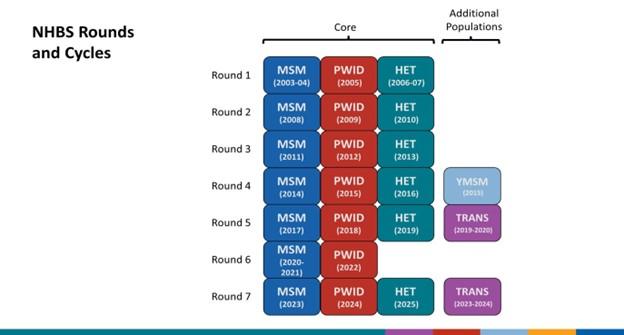
Georgia HIV Behavioral Surveillance (GHBS)
Overview of GHBS
The Georgia Department of Public Health is one of over 20 national recipients from a metropolitan statistical area (MSA) to participate in the CDC National HIV Behavioral Surveillance project (NHBS). NHBS aims to collect data on behavioral risk factors for HIV. Georgia’s project (referred to as the Georgia HIV Behavioral Surveillance project [GHBS]) operates in the Atlanta MSA and has been conducted since 2003 when NHBS began.
Participants are surveyed through an anonymous questionnaire on their:
- behavioral risk factors for HIV (e.g., sexual behaviors, drug use) and
- HIV testing behaviors, receipt of prevention services, and use of prevention strategies (e.g., condoms, PrEP).
All participants are offered an optional HIV test regardless of their self-reported status. Referrals to care are made to local agencies as needed.
Survey Rounds and Cycles
GHBS is currently conducting surveillance in its seventh round. A survey round consists of three survey cycles for core populations at increased risk for HIV, and on occasion, additional population cycles. The goal of every round is to conduct at least 500 surveys per project site each year for the core populations. Due to disruptions from the COVID-19 pandemic, some cycles have been conducted out of sequence. For more information on survey methods, see National HIV Behavioral Surveillance (NHBS) | HIV Data | CDC.

The three core survey populations are:
- Gay, bisexual and other men who have sex with men (MSM): During the MSM cycle, the GHBS team collects information on persons who report sex with a male partner in the 12 months before the interview.
- Persons who inject drugs (PWID): During the PWID cycle, the GHBS team collects information on persons who report injecting a drug that was not prescribed for them in the 12 months before the interview.
- Heterosexually active persons at increased risk for HIV infection (HET): During the HET cycle, the GHBS team collects information on heterosexually active persons at increased risk for HIV reporting sex with an opposite sex partner in the 12 months before the interview.
A limited number of project areas conduct surveys with the following additional populations:
- Women of trans experience and transfeminine people (TRANS): During the TRANS cycle, the GHBS team collected information on women of trans experience and transfeminine people, especially of color, who are disproportionately affected by HIV.
- Young MSM (YMSM): The GHBS team conducted a YMSM cycle dedicated to surveying young MSM within the ages of 18-24 year old.
GHBS Project Aims
The GHBS project aims include:
- developing an ongoing surveillance system to ascertain the prevalence of HIV risk behaviors among groups at increased risk for HIV infection,
- engaging community-based organizations (CBOs) in surveillance and questionnaire development,
- collaborating with HIV prevention programs to assess exposure to and use of local HIV prevention programs, and
- presenting data on populations at increased risk to guide national, state, and local prevention and treatment service planning and evaluation.
Georgia Health and Behavioral Survey Data
Data Summaries
These data summaries describe results from the GHBS surveys, including demographic characteristics, behavioral risk factors for HIV, testing behaviors, and receipt and use of prevention programs among populations at increased risk for HIV.
Contact Us
HIV Epidemiology Unit
1-800-827-9769
Background Information on NHBS
The goal of NHBS is to provide data to support and guide the understanding of best practices for improvement of HIV prevention and care services on local, state, and federal levels. In 2003, the CDC created NHBS to conduct bio-behavioral surveillance among populations disproportionately affected by HIV among 20+ MSA recipient project sites. Locations are chosen based upon the prevalence of HIV in an area and has included locales in the contiguous United States and San Juan, Puerto Rico. The CDC funds recipient project sites in five-year grant cycles.
More Information
Case Reporting: For instructions on how to report HIV and AIDS cases and lab reports, see HIV and AIDS Case Reporting.
How To Request Data: To request data beyond what is included on the GA DPH website, please visit PHIP Data Request to create a PHIP data request account and complete the data request form.
National Surveillance: National HIV Behavioral Surveillance (NHBS) | CDC
Page last updated 10/23/2025